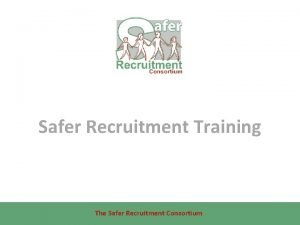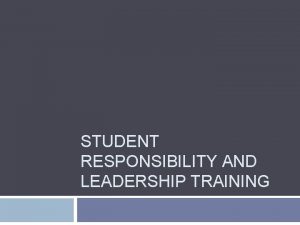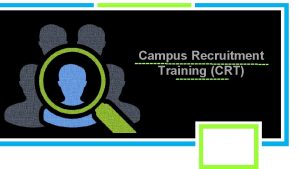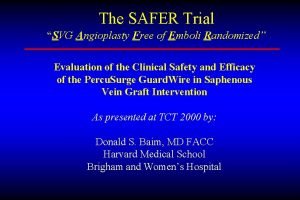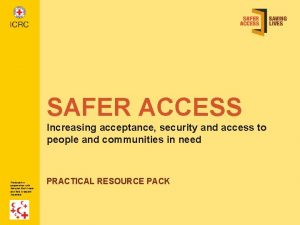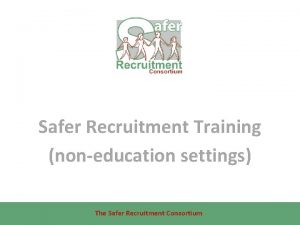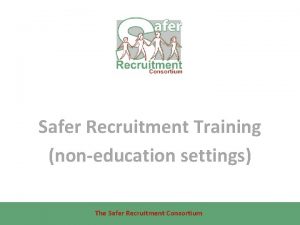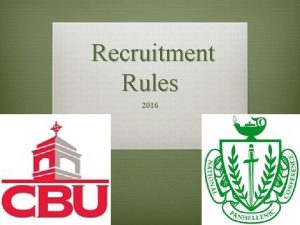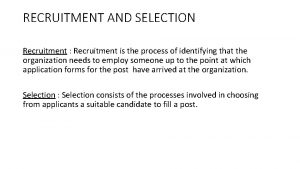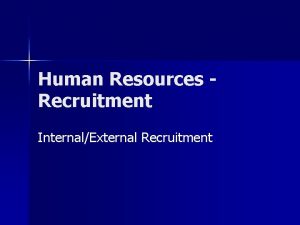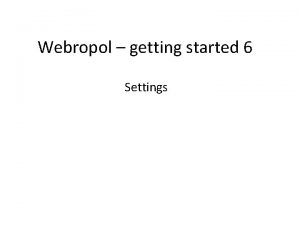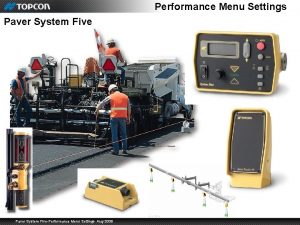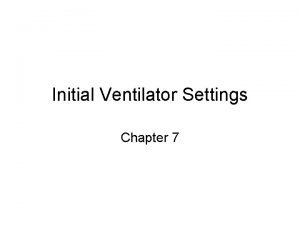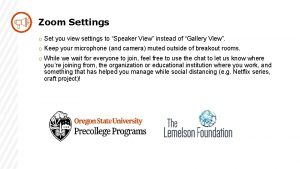Safer Recruitment Training noneducation settings The Safer Recruitment



















































- Slides: 51

Safer Recruitment Training (non-education settings) The Safer Recruitment Consortium

The Bichard Inquiry Recommendations for schools Recommendation 16: • Head teachers and school governors should receive training on how to ensure that interviews to appoint staff reflect the importance of safeguarding children. Recommendation 17: • From a date to be agreed, no interview panel to appoint staff working in schools and colleges should be convened without at least one member being properly trained. The Safer Recruitment Consortium

Objectives of the training Based on an understanding of offender behaviour to: • Identify the key features of staff recruitment that help deter or prevent the appointment of unsuitable people • Consider policies and practice that minimise opportunities for abuse or ensure its prompt reporting • Help participants begin to review their policies and practice in recruitment with a view to creating a safer culture NB this is not intended to be a comprehensive workshop on staff recruitment and selection The Safer Recruitment Consortium

Training outline • Scale of the problem – abused and abuser • A model to understand abusers / abusing • Application into a wider children’s workforce context • Prevention of abuse through recruitment/selection • Ongoing culture of vigilance The Safer Recruitment Consortium

Session 1 – setting the context for safer recruitment • Background and context • The scale of abuse • A model of offending behaviour • Some characteristics of abusers • Implications for recruitment and selection and creating a safer environment for children and young people The Safer Recruitment Consortium

The wider context • The Bichard Inquiry Report • Legal duties on a wide range of organisations to safeguard and promote the welfare of children (Children Act 1989 / 2004) • Sector specific guidance – e. g. EYFS welfare standards, Children’s Home quality standards • Statutory guidance ‘Working together to safeguard children’ (Df. E 2018) • Implications of recent inquiries for health and other care services • Adopting “safer recruitment” practice is an essential feature of the arrangements organisations need to have in place The Safer Recruitment Consortium

Statistics – LADO referrals • About 40% of allegations are for physical abuse and 36% for sexual abuse • Varied significantly across different regions but 12 – 24% relate to emotional abuse or neglect • Where it is recorded as a separate category, 9% of allegations relate to conduct outside the workplace • Schools make up 1/3 rd of all LADO referrals Review of LSCB annual reports 2015 -16 / 2016 -27 (Eyre 2017) The Safer Recruitment Consortium

Statistics - DBS • 7, 994 referrals for discretionary barring in 2018/19 • There were 67, 313 people on the children’s barred list in March 2019 • There were 73, 589 people on one or both lists • Approx 330, 000 enhanced DBS certificates are processed each month • On average, 6% include PNC data • 0. 1% also include additional info after filtering has been applied • 0. 01% of DBS applications have a barred list match Disclosure & Barring Service May 2019 The Safer Recruitment Consortium

Children’s experiences of sexual abuse: April 2012 – March 2014 49, 673 referred to children’s social care Estimated 425, 000 – 450, 000 children experienced CSA 6, 414 offenders convicted The Safer Recruitment Consortium 37, 844 cases recorded by police Protecting children from harm (Children’s Commissioner Nov 2015) suggests that approximately 1 in 8 victims of CSA come to the attention of statutory agencies. This finding is consistent with various other pieces of research.

Reasons victims don’t report abuse it was nobody else’s business didn’t think it was serious or wrong didn’t want parents to find out didn’t want friends to find out didn’t want the authorities to find out frightened didn’t think they would be believed desire to protect the abuser / abuser is main carer • communication difficulties • • The Safer Recruitment Consortium

Who are the sex offenders? • 97. 8% of those charged with a sexual offence are male • Victim studies suggest that 1 in 9 sexual offences are committed by a woman • Between 2004 – 2009 Childline saw a 132% increase in number of children reporting sexual abuse by a woman Source: Darling 2017 “Between 23 -40% of alleged sexual abuse of children and young people is perpetrated by other young people, mainly adolescents” Source: Harmful sexual behaviour NSPCC 2013 “The majority of perpetrators sexually assault children known to them, with about 80% of offences taking place in the home of either the offender or the victim” Source: Sexual Offending against Children: Understanding the Risk Grubin (1998) The Safer Recruitment Consortium

Finkelhor – four preconditions Adapted from D Finkelhor Child Sexual Abuse: New Theory & Research 1986 Sex with a child Thoughts Motivation Internal inhibitors ‘wanting to’ ‘conscience’ The Safer Recruitment Consortium External inhibitors Overcome victim resistance ‘creating opportunity’ ‘doing it and getting away with it’

Exercise 2 - audio presentation The grid provided in your hand-out contains the stages of Finkelhor’s model • As the clip plays write down, in the appropriate box, what the offender says about this pattern of abusing The Safer Recruitment Consortium

‘Professional perpetrators’ 92. 5% aware of interest by 21 67. 5% offended by 21 15% chose career solely to abuse 41. 5% state abuse part of motivation 77. 5% arranged meetings outside work for abuse • 67. 5% took children away overnight • Average of 49 admitted victims • 41. 9% had reputation as ‘touchy’, ‘pervy’ etc. • • • Source: Sullivan & Beech 2004 – Sample of 41 workers with children who were serious sexual offenders The Safer Recruitment Consortium

Strategies to gain a child’s trust • • • Spending lots of time with them Touching non-sexually Sharing personal information Telling them they are special Treating them like adults Playing with them Saying loving / caring things Giving special rewards / privilege Talking like you are their age 95% 91% 78% 70% 70% 65% 43% 35% Leclerc, Proulxt & Mc. Kibben: 2005 The Safer Recruitment Consortium

Strategies to desensitise a victim to sexual contact • • Touching non-sexually Saying loving / caring things Getting victims sexually excited or curious Talking more and more about sex 95% 70% 65% 60% Leclerc, Proulxt & Mc. Kibben: 2005 The Safer Recruitment Consortium

Strategies to maintain a victim’s silence • • • Saying the child will get into trouble Giving rewards for secrecy Saying they will go to jail Saying others would think they are gay Threats to harm or injure 35% 21% 17% 13% 0% Leclerc, Proulxt & Mc. Kibben: 2005 The Safer Recruitment Consortium

Other behaviours often displayed include: • Poor boundary keeping • Breaching policy or procedures ‘in the best interests’ of the child, client or organisation • Lack of awareness of their behaviour on others • Charismatic • Dutiful, over-helpful and committed The Safer Recruitment Consortium

Applying the Finkelhor model to recruitment • Deter • Reject • Prevent Application stage • Prevent & Detect Developing and maintaining a culture of vigilance The Safer Recruitment Consortium Interview stage Appointment and induction

“For those agencies whose job it is to protect children and vulnerable people, the harsh reality is that if a sufficiently devious person is determined to seek out opportunities to work their evil, no one can guarantee that they will be stopped. Our task is to make it as difficult as possible for them to succeed. . . ” Bichard Inquiry Report, 2004, p 12 para 79 The Safer Recruitment Consortium

Session 2: a safer recruitment process • Features of a safer recruitment process for : employees, contractors, agencies & volunteers • Sending the right message • The application form • The selection criteria • References • Review and next steps The Safer Recruitment Consortium

Defining the role • Produce a job description and person specification or volunteer role profile • Include skills, abilities, experience, behaviours and attitude/motivation and values towards children and young people • Boundaries of role and expectations • Responsibilities and opportunity for contact with vulnerable groups – is it Regulated Activity? The Safer Recruitment Consortium

Advertising: Sending the right message Three deterrents • State the organisation’s commitment to safeguarding and/or the need for DBS and other vetting checks in adverts • Include statements about the safeguarding responsibilities of the post in the job description and person specification • Send information about the organisation’s safeguarding policy and practices to candidates The Safer Recruitment Consortium

Key information on application forms • Personal details • Present employment and reason for leaving • Full history since leaving school (education and employment or voluntary work) • Qualifications • Referees • Personal statement to meet person specification • Signed declaration about relevant criminal record • Signed declaration that all information is true The Safer Recruitment Consortium

Criminal background: Self-disclosures Purpose • To give candidates an opportunity to share relevant information at an early stage • To allow information to be discussed and considered before the DBS check comes back • To deter unsuitable people Process • • It is discriminatory to use disclosed information for shortlisting Only consider the information of shortlisted candidates Should not rule someone out – apply fair assessment criteria Continue with DBS check and compare information The Safer Recruitment Consortium

Agreeing selection criteria and process • Base criteria for shortlisting and assessment process on person specification and job description • Consistent for all candidates • Specific to work with children • Review criteria regularly The Safer Recruitment Consortium

Scrutinising applications and short listing Take time to properly scrutinise At least two people shortlisting Identify any inconsistencies Application form fully completed Evidence provided relating to person specification and job description • Scrutinise for gaps • Apply shortlisting criteria equally • • • The Safer Recruitment Consortium

References Important part of process of gathering information: • Must have a reference from current employer • If not currently working with children but has done so in the past, at least one reference should be from that employment • Ask whether aware of any behaviour that might give rise to concern, including any disciplinary action • Ask specifically about allegations about their behaviour towards children • Specific confirmation of the details and responsibilities of previous post given by applicant • Consideration of any request by an applicant to delay seeking references from their current employer The Safer Recruitment Consortium

Open references and testimonials Candidates may sometimes bring ‘open’ references or letters of recommendation to interview. These: • May be the product of a settlement agreement to avoid disciplinary action • Should never be accepted at face value Always take up your own references and/or contact the author of the open reference to verify the content The Safer Recruitment Consortium

Scrutinising references • Importance of reading references – active consideration • Equally, importance of comparing information provided by referee with information provided by applicant • If any inconsistencies, or doubts about suitability, follow up and explore with referee • In residential settings, references should always be confirmed by telephone The Safer Recruitment Consortium

Session 3: making the right decisions • • • Importance of making the right decision The interview and the selection process Pre-appointment checks Using criminal disclosure information Review and next steps The Safer Recruitment Consortium

Safer selection Good practice • Range of selection tools – not just an interview • Explore motives/attitudes as well as skills and experience • Assessors should be well briefed or trained • Assess interaction with others – role plays, group exercises • Appropriate involvement of children The Safer Recruitment Consortium

Selecting the right people Interviews • At least two people • Structured questions and criteria previously agreed • Probe gaps, frequent changes in employment, vagueness or areas of concern • Ask about attitudes towards child protection / safeguarding and where appropriate motives for working with vulnerable groups • Avoid hypothetical questions and seek positive examples or evidence • Clearly document your decisions • Beware of prejudices and discrimination The Safer Recruitment Consortium

Making decisions using selection criteria and indicators • Based on the Person Specification • Indicators – what would you expect a good candidate to say? • Guide not a tick box • Bespoke to the position • Use to make decisions and clarify why someone is suitable or unsuitable for appointment • Review regularly The Safer Recruitment Consortium

Areas of potential concern • No understanding or appreciation of children’s needs • Wanting role to meet own needs at the expense of children • Inappropriate language when talking about children • Expression of views that are extreme or do not support safeguarding • Unclear boundaries with children • Vagueness about experiences and gaps or unable to provide any examples to support what they tell you • Maverick – non rule-following, unwilling to work with others The Safer Recruitment Consortium

Interview question template Positive Indicators Emotional Resilience & Maturity • Consistent under pressure • Has control over emotions • Knows when to seek help • Tell me about a • Inappropriate time when your responses under authority was pressure or when challenged. in charge of • What happened? others. • How did you react? • Handles conflict • What did you do to badly. bring things back on • Doesn’t seek help course? when needed. The Safer Recruitment Consortium Negative Indicators

Pre-appointment checks A conditional offer of employment can be made pending the following checks: • Identity - including DOB • Eligibility to work in the UK • DBS Barred List (replaced List 99/Po. CA/Po. VA lists in 2009) • Enhanced DBS certificate • Qualifications • Status: HCPC, BACP registration, etc • Disqualification from childcare / disqualification by association (*Early years / later years childcare only) • Overseas checks (e. g. police check / certificate of good conduct / overseas reference) The Safer Recruitment Consortium

Regulated activity & DBS checks • Individuals employed to work regularly in a specified place or certain roles are in regulated activity (RA) with children • It is a legal requirement to check people working in RA are not barred from that work before they commence in post • People not in RA can still be asked to undertake a DBS disclosure (without Barred list check) • It is unlawful to check the Barred list if the person is not in RA • Employer must see the original certificate and should only retain a copy in certain circumstances The Safer Recruitment Consortium

DBS Barred list - children At present people are barred by law from working in RA with children if they are: • on the DBS children’s barred list • banned by a court on conviction of a specified offence A DBS certificate obtained in regard to work with children will usually* show whether the person is barred from RA with children. * But not in the case of supervised volunteers People barred from working in RA with adults are not automatically barred from working with children or vice versa The Safer Recruitment Consortium

Relevance of criminal records When assessing an applicant’s criminal history, consider the offence in terms of • Nature, seriousness and relevance • How long ago it occurred • Whether it was a one-off or part of a history • Circumstances of it being committed • Changes in applicant’s personal circumstances • Country of conviction • Decriminalisation It is unlawful to take offences that are ‘protected’ into account The Safer Recruitment Consortium

Protected offences • The Rehabilitation of Offenders Act 1974 was amended in 2013 • Employers should not ask candidates to disclose spent convictions, even if the post is exempt from the ROA • Legislation now refers to ‘filtered’ or ‘protected’ offences which applicants do not need to disclose • It is the employer’s responsibility to draw applicants’ attention to the guidance on disclosure of offences that are not ‘protected’ or ‘filtered’ • See p 18 of the delegate workbook for the wording recommended by the Home Office – this should be used on application forms, applicant information packs, etc • If an applicant discloses an offence which they did not need to, it is the recruiter’s responsibility to know not to discuss / take it into consideration The Safer Recruitment Consortium

Session 4: an ongoing culture of vigilance • • • Features of a safer culture Audio presentation Creating an open culture Individual responsibilities for expressing concern Dealing with allegations of professional abuse Next steps and other resources The Safer Recruitment Consortium

Features of a safer culture • • Open, no secrets Belief that ‘it could happen here’ Setting acceptable standards of behaviour Clear procedures for reporting concerns and whistleblowing Support in raising concerns and commitment to take action Commitment to safeguarding and an ongoing culture of vigilance Policies and procedures put into practice Induction and probationary periods The Safer Recruitment Consortium

Discussion – creating an open culture Empowering and encouraging members of staff and volunteers to report concerns or allegations about the behaviour of others is essential if we are going to tackle inappropriate or abusive behaviour. Please consider and discuss: • What might stop me reporting concerns? • What would help me overcome those problems? The Safer Recruitment Consortium

Dealing with allegations against staff and volunteers Working Together (Df. E 2018) outlines the framework that should be followed when it is alleged that a member of staff or volunteer in an establishment providing services to children under 18 has: • Behaved in a way that has harmed a child or may have harmed a child • Possibly committed a criminal offence against or related to a child • Behaved towards a child or children in a way that indicates he or she may pose a risk of harm to children The Safer Recruitment Consortium

Breach of Trust A breach of trust occurs when the boundaries of the relationship between a professional and a child or young person is broken due to inappropriate behaviour by the professional, which involves an abuse of power. The behaviour itself does not necessarily have to be illegal to breach this trust – even if the child is over the age of consent e. g: • A youth leader (19 years old) at a youth club starts a relationship with a 16 year old youth club member • A teacher becomes sexually involved with a 6 th form pupil Is there an equivalent example in your sector? The Safer Recruitment Consortium

Structure for managing allegations Working Together to Safeguard Children (Df. E 2018) Proprietor / Head of service / registered manager Local authority designated officer (LADO) The Safer Recruitment Consortium Named senior officers for all partner organisations Multi-agency partnership (MAP)

Safe working practices Child Protection Induction & training A ‘listening’ culture Governance Whistle blowing Allegations management procedures Supervision ONGOING CULTURE OF VIGILANCE Teaching resilience / wellbeing Online safety Safer recruitment & selection The Safer Recruitment Consortium The physical environment

Remaining vigilant • Never think you have done enough in terms of creating a safer culture • Always believe it could happen here • Keep safeguarding high on everyone’s agenda • Never rely on any one process to keep children safe The Safer Recruitment Consortium

“Safer organisations” “. . it seems clear that the optimal approach to maximise the protection of children from harm by staff and volunteers is a thorough and consistently implemented recruitment and selection process and an organisation with clear values and expected behaviours which consciously integrates a situational prevention approach into practice. ” Erooga, Allnock & Telford 2012 Thank you – any questions? The Safer Recruitment Consortium

The Safer Recruitment Consortium © 2020 The Safer Recruitment Consortium
 Safer recruitment consortium
Safer recruitment consortium Definition of recruitment in management
Definition of recruitment in management Leader training recruitment
Leader training recruitment Crt aptitude
Crt aptitude Hình ảnh bộ gõ cơ thể búng tay
Hình ảnh bộ gõ cơ thể búng tay Slidetodoc
Slidetodoc Bổ thể
Bổ thể Tỉ lệ cơ thể trẻ em
Tỉ lệ cơ thể trẻ em Voi kéo gỗ như thế nào
Voi kéo gỗ như thế nào Tư thế worm breton là gì
Tư thế worm breton là gì Hát lên người ơi alleluia
Hát lên người ơi alleluia Môn thể thao bắt đầu bằng chữ f
Môn thể thao bắt đầu bằng chữ f Thế nào là hệ số cao nhất
Thế nào là hệ số cao nhất Các châu lục và đại dương trên thế giới
Các châu lục và đại dương trên thế giới Công thức tiính động năng
Công thức tiính động năng Trời xanh đây là của chúng ta thể thơ
Trời xanh đây là của chúng ta thể thơ Mật thư tọa độ 5x5
Mật thư tọa độ 5x5 Làm thế nào để 102-1=99
Làm thế nào để 102-1=99 Phản ứng thế ankan
Phản ứng thế ankan Các châu lục và đại dương trên thế giới
Các châu lục và đại dương trên thế giới Thể thơ truyền thống
Thể thơ truyền thống Quá trình desamine hóa có thể tạo ra
Quá trình desamine hóa có thể tạo ra Một số thể thơ truyền thống
Một số thể thơ truyền thống Bàn tay mà dây bẩn
Bàn tay mà dây bẩn Vẽ hình chiếu vuông góc của vật thể sau
Vẽ hình chiếu vuông góc của vật thể sau Nguyên nhân của sự mỏi cơ sinh 8
Nguyên nhân của sự mỏi cơ sinh 8 đặc điểm cơ thể của người tối cổ
đặc điểm cơ thể của người tối cổ Thế nào là giọng cùng tên? *
Thế nào là giọng cùng tên? * Vẽ hình chiếu đứng bằng cạnh của vật thể
Vẽ hình chiếu đứng bằng cạnh của vật thể Fecboak
Fecboak Thẻ vin
Thẻ vin đại từ thay thế
đại từ thay thế điện thế nghỉ
điện thế nghỉ Tư thế ngồi viết
Tư thế ngồi viết Diễn thế sinh thái là
Diễn thế sinh thái là Các loại đột biến cấu trúc nhiễm sắc thể
Các loại đột biến cấu trúc nhiễm sắc thể So nguyen to
So nguyen to Tư thế ngồi viết
Tư thế ngồi viết Lời thề hippocrates
Lời thề hippocrates Thiếu nhi thế giới liên hoan
Thiếu nhi thế giới liên hoan ưu thế lai là gì
ưu thế lai là gì Khi nào hổ mẹ dạy hổ con săn mồi
Khi nào hổ mẹ dạy hổ con săn mồi Khi nào hổ mẹ dạy hổ con săn mồi
Khi nào hổ mẹ dạy hổ con săn mồi Sơ đồ cơ thể người
Sơ đồ cơ thể người Từ ngữ thể hiện lòng nhân hậu
Từ ngữ thể hiện lòng nhân hậu Thế nào là mạng điện lắp đặt kiểu nổi
Thế nào là mạng điện lắp đặt kiểu nổi Safer
Safer 8 elements of safer access
8 elements of safer access Where are we as act 2 begins
Where are we as act 2 begins Engineering a safer world
Engineering a safer world Maybo safer model
Maybo safer model Characteristics of expressway driving
Characteristics of expressway driving
